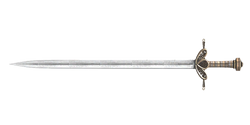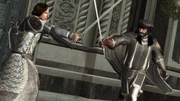m (Sol Pacificus moved page Common Sword to Common sword: Since it is not a unique sword and is a regular sword model with many copies, the name is a general noun not a proper noun.) |
m (+fr) |
||
| (5 intermediate revisions by 4 users not shown) | |||
| Line 1: | Line 1: | ||
| − | {{Era| |
+ | {{Era|Weapons}} |
| − | {{Youmay|the '''basic sword of the Renaissance'''|the '''[[normal sword]]''' of the American Revolution}} |
||
[[File:AcII-common-sword.png|thumb|250px|The Common Sword]] |
[[File:AcII-common-sword.png|thumb|250px|The Common Sword]] |
||
| − | + | The '''Common Sword''' was a [[Swords|sword]] of basic design in [[Italy]] during the [[Renaissance]]. It was a widely prevalent type of sword, sold across many cities including [[Florence]], [[Monteriggioni]], [[San Gimignano]], [[Forlì]], and [[Rome]]. Accordingly, it saw service with the militaries and [[guards]] of [[Europe]] in that period. |
|
==Description== |
==Description== |
||
| − | The |
+ | The Common Sword bore a relatively simple design, being a double-edged straight sword with a typical hilt and crossguard. Compared to swords of other make during the Renaissance, Common Swords were mediocre and were among the cheapest in Italy. It afforded little protection and was considered to be among the weakest weapons.<ref name="AC2">''[[Assassin's Creed II]]''</ref> |
==History== |
==History== |
||
| − | On 28 December 1476, when the Florentine [[Assassins|Assassin]] [[Giovanni Auditore da Firenze]] and his sons [[Federico Auditore da Firenze|Federico]] and [[Petruccio Auditore da Firenze|Petruccio]] were arrested on false charges of treason, he instructed his son [[Ezio Auditore da Firenze|Ezio]] from his cell to retrieve all the contents within a chest left in his office at their [[Villa Auditore|villa]]. Ezio did as he was told, and aside from his father's Assassin uniform, a broken [[Hidden Blade]], and a letter with evidence of the [[Pazzi conspiracy]], he acquired a |
+ | On 28 December 1476, when the Florentine [[Assassins|Assassin]] [[Giovanni Auditore da Firenze]] and his sons [[Federico Auditore da Firenze|Federico]] and [[Petruccio Auditore da Firenze|Petruccio]] were arrested on false charges of treason, he instructed his son [[Ezio Auditore da Firenze|Ezio]] from his cell to retrieve all the contents within a chest left in his office at their [[Villa Auditore|villa]]. Ezio did as he was told, and aside from his father's Assassin uniform, a broken [[Hidden Blade]], and a letter with evidence of the [[Pazzi conspiracy]], he acquired a Common Sword. The following day during his family's execution at the [[Piazza della Signoria]], Ezio wielded the sword to defend himself from the guards ordered to kill him, only to lose it in the skirmish.<ref name="AC2" /> |
| − | Following his journey to [[Monteriggioni]], [[Mario Auditore]] presented him with a replacement. Common |
+ | Following his journey to [[Monteriggioni]], [[Mario Auditore]] presented him with a replacement. Common Swords were also wielded by other figures from the time, including [[Lorenzo de' Medici]], [[Francesco de' Pazzi]], and [[Rodrigo Borgia]].<ref name="AC2"/> In 1500, upon his arrival in Rome, Ezio was given this sword again by [[Niccolò Machiavelli]] as he had lost all of his equipment in [[Cesare Borgia]]'s [[Siege of Monteriggioni|assault]] on Monteriggioni.<ref>''[[Assassin's Creed: Brotherhood]]''</ref> |
==Weapon statistics== |
==Weapon statistics== |
||
| Line 45: | Line 44: | ||
{{Reflist}} |
{{Reflist}} |
||
| + | [[fr:Épée commune]] |
||
[[uk:Звичайний меч]] |
[[uk:Звичайний меч]] |
||
[[Category:Swords]] |
[[Category:Swords]] |
||
Revision as of 23:37, 20 June 2018

The Common Sword
The Common Sword was a sword of basic design in Italy during the Renaissance. It was a widely prevalent type of sword, sold across many cities including Florence, Monteriggioni, San Gimignano, Forlì, and Rome. Accordingly, it saw service with the militaries and guards of Europe in that period.
Description
The Common Sword bore a relatively simple design, being a double-edged straight sword with a typical hilt and crossguard. Compared to swords of other make during the Renaissance, Common Swords were mediocre and were among the cheapest in Italy. It afforded little protection and was considered to be among the weakest weapons.[1]
History
On 28 December 1476, when the Florentine Assassin Giovanni Auditore da Firenze and his sons Federico and Petruccio were arrested on false charges of treason, he instructed his son Ezio from his cell to retrieve all the contents within a chest left in his office at their villa. Ezio did as he was told, and aside from his father's Assassin uniform, a broken Hidden Blade, and a letter with evidence of the Pazzi conspiracy, he acquired a Common Sword. The following day during his family's execution at the Piazza della Signoria, Ezio wielded the sword to defend himself from the guards ordered to kill him, only to lose it in the skirmish.[1]
Following his journey to Monteriggioni, Mario Auditore presented him with a replacement. Common Swords were also wielded by other figures from the time, including Lorenzo de' Medici, Francesco de' Pazzi, and Rodrigo Borgia.[1] In 1500, upon his arrival in Rome, Ezio was given this sword again by Niccolò Machiavelli as he had lost all of his equipment in Cesare Borgia's assault on Monteriggioni.[2]
Weapon statistics
| Era | Damage | Speed | Deflect | Cost | Availability |
| 15th century Italy | 1 | 1 | 2 | N/A | Sequence 3 |
| 16th century Rome | 1 | 2 | 2 | N/A | Sequence 1 |


